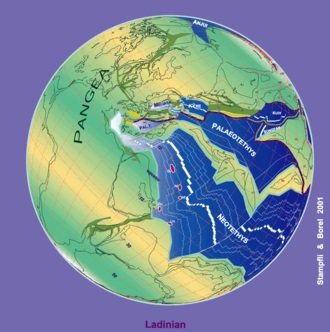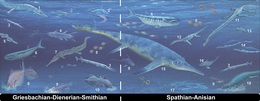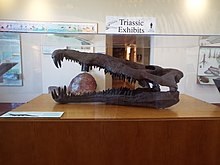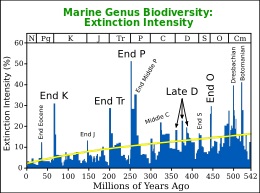|
|
| |
|
|
| |
|
|
|
|
| |
 |
| Sydney, Australia
lies on Triassic shales and sandstones. Almost
all of the exposed rocks around Sydney belong to
the Triassic Sydney sandstone. |
Triassic
The Triassic (/traɪˈæs.ɪk/ try-ASS-ik) is a geologic
period and system which spans 50.6 million years from
the end of the Permian Period 251.902 million years ago
(Mya), to the beginning of the Jurassic Period 201.36
Mya. The Triassic is the first and shortest period of
the Mesozoic Era. Both the start and end of the period
are marked by major extinction events. The Triassic
period is subdivided into three epochs: Early Triassic,
Middle Triassic and Late Triassic.
The Triassic began in the wake of the Permian–Triassic
extinction event, which left the Earth's biosphere
impoverished; it was well into the middle of the
Triassic before life recovered its former diversity.
Therapsids and archosaurs were the chief terrestrial
vertebrates during this time. A specialized subgroup of
archosaurs, called dinosaurs, first appeared in the Late
Triassic but did not become dominant until the
succeeding Jurassic Period.
The first true mammals, themselves a specialized
subgroup of therapsids, also evolved during this period,
as well as the first flying vertebrates, the pterosaurs,
who, like the dinosaurs, were a specialized subgroup of
archosaurs. The vast supercontinent of Pangaea existed
until the mid-Triassic, after which it began to
gradually rift into two separate landmasses, Laurasia to
the north and Gondwana to the south.
The global climate during the Triassic was mostly hot
and dry, with deserts spanning much of Pangaea's
interior. However, the climate shifted and became more
humid as Pangaea began to drift apart. The end of the
period was marked by yet another major mass extinction,
the Triassic–Jurassic extinction event, that wiped out
many groups and allowed dinosaurs to assume dominance in
the Jurassic.
Etymology
The Triassic was named in 1834 by Friedrich von Alberti,
after the three distinct rock layers (tri meaning
"three") that are found throughout Germany and
northwestern Europe—red beds, capped by marine
limestone, followed by a series of terrestrial mud- and
sandstones—called the "Trias". |
|
|
Dating and subdivisions
The Triassic is usually separated into Early, Middle,
and Late Triassic Epochs, and the corresponding rocks
are referred to as Lower, Middle, or Upper Triassic. The
faunal stages from the youngest to oldest are: |
- Upper/Late Triassic (Tr3)
- Rhaetian (205.7–201.36 Mya)
- Norian (228.4–205.7 Mya)
- Carnian (237–228.4 Mya)
- Middle Triassic (Tr2)
- Ladinian (241.5–237 Mya)
- Anisian (246.8–241.5 Mya)
- Lower/Early Triassic (Scythian)
- Olenekian (249.8–246.8 Mya)
- Induan (251.902–249.8 Mya)
|
|
 |
| 230 Ma plate
tectonic reconstruction. |
Paleogeography
During the Triassic, almost all the Earth's land mass was
concentrated into a single supercontinent centered more or
less on the equator and spanning from pole to pole, called
Pangaea ("all the land"). From the east, along the equator,
the Tethys sea penetrated Pangaea, causing the Paleo-Tethys
Ocean to be closed.
Later in the mid-Triassic a similar sea penetrated along the
equator from the west. The remaining shores were surrounded
by the world-ocean known as Panthalassa ("all the sea"). All
the deep-ocean sediments laid down during the Triassic have
disappeared through subduction of oceanic plates; thus, very
little is known of the Triassic open ocean.
The supercontinent Pangaea was rifting during the
Triassic—especially late in that period—but had not yet
separated. The first nonmarine sediments in the rift that
marks the initial break-up of Pangaea, which separated New
Jersey from Morocco, are of Late Triassic age; in the U.S.,
these thick sediments comprise the Newark Group.
Because a super-continental mass has less shoreline compared
to one broken up, Triassic marine deposits are globally
relatively rare, despite their prominence in Western Europe,
where the Triassic was first studied. In North America, for
example, marine deposits are limited to a few exposures in
the west. Thus Triassic stratigraphy is mostly based on
organisms that lived in lagoons and hypersaline
environments, such as Estheria crustaceans.
Africa
At the beginning of the Mesozoic Era, Africa was joined with
Earth's other continents in Pangaea. Africa shared the
supercontinent's relatively uniform fauna which was
dominated by theropods, prosauropods and primitive
ornithischians by the close of the Triassic period. Late
Triassic fossils are found throughout Africa, but are more
common in the south than north. The time boundary separating
the Permian and Triassic marks the advent of an extinction
event with global impact, although African strata from this
time period have not been thoroughly studied.
Scandinavia
During the Triassic peneplains are thought to have formed in
what is now Norway and southern Sweden. Remnants of this
peneplain can be traced as a tilted summit accordance in the
Swedish West Coast. In northern Norway Triassic peneplains
may have been buried in sediments to be then re-exposed as
coastal plains called strandflats. Dating of illite clay
from a strandflat of Bømlo, southern Norway, have shown that
landscape there became weathered in Late Triassic times (c.
210 million years ago) with the landscape likely also being
shaped during that time.
South America
At Paleorrota geopark, located in Rio Grande do Sul, Brazil,
the Santa Maria Formation and Caturrita Formations are
exposed. In these formations, one of the earliest dinosaurs,
Staurikosaurus, as well as the mammal ancestors
Brasilitherium and Brasilodon have been discovered.
Climate
The Triassic continental interior climate was generally hot
and dry, so that typical deposits are red bed sandstones and
evaporites. There is no evidence of glaciation at or near
either pole; in fact, the polar regions were apparently
moist and temperate, providing a climate suitable for
forests and vertebrates, including reptiles. Pangaea's large
size limited the moderating effect of the global ocean; its
continental climate was highly seasonal, with very hot
summers and cold winters. The strong contrast between the
Pangea supercontinent and the global ocean triggered intense
cross-equatorial monsoons.
The Triassic may have mostly been a dry period, but evidence
exists that it was punctuated by several episodes of
increased rainfall in tropical and subtropical latitudes of
the Tethys Sea and its surrounding land. Sediments and
fossils suggestive of a more humid climate are known from
the Anisian to Ladinian of the Tethysian domain, and from
the Carnian and Rhaetian of a larger area that includes also
the Boreal domain (e.g., Svalbard Islands), the North
American continent, the South China block and Argentina.
The best studied of such episodes of humid climate, and
probably the most intense and widespread, was the Carnian
Pluvial Event. A 2020 study found bubbles of carbon dioxide
in basaltic rocks dating back to the end of the Triassic,
and concluded that volcanic activity helped trigger climate
change in that period. |
|
 |
| Marine vertebrate
apex predators of the Early Triassic. |
Life
Three categories of organisms can be distinguished in
the Triassic record: survivors from the Permian–Triassic
extinction event, new groups which flourished briefly,
and other new groups which went on to dominate the
Mesozoic Era.
Flora
On land, the surviving vascular plants included the
lycophytes, the dominant cycadophytes, ginkgophyta
(represented in modern times by Ginkgo biloba), ferns,
horsetails and glossopterids. The spermatophytes, or
seed plants, came to dominate the terrestrial flora: in
the northern hemisphere, conifers, ferns and
bennettitales flourished. The seed fern genus Dicroidium
would dominate Gondwana throughout the period.
Plankton
Before the Permian extinction, Archaeplastida (red and
green algae) had been the major marine phytoplanktons
since about 659–645 million years ago, when they
replaced marine planktonic cyanobacteria, which first
appeared about 800 million years ago, as the dominant
phytoplankton in the oceans. In the Triassic, secondary
endosymbiotic algae became the most important plankton. |
 |
| Middle Triassic
marginal marine sequence, southwestern Utah. |
Marine fauna
In marine environments, new modern types of corals
appeared in the Early Triassic, forming small patches of
reefs of modest extent compared to the great reef
systems of Devonian or modern times. Serpulids appeared
in the Middle Triassic. Microconchids were abundant. The
shelled cephalopods called ammonites recovered,
diversifying from a single line that survived the
Permian extinction.
The fish fauna was remarkably uniform, with many
families and genera exhibiting a global distribution in
the wake of the mass extinction event. Ray-finned fishes
went through a remarkable diversification during the
Triassic, leading to peak diversity during the Middle
Triassic; however, the pattern of this diversification
is still not well understood due to a taphonomic
megabias. There were also many types of marine reptiles.
These included the Sauropterygia, which featured
pachypleurosaurus and nothosaurs (both common during the
Middle Triassic, especially in the Tethys region),
placodonts, and the first plesiosaurs. The first of the
lizardlike Thalattosauria (askeptosaurs) and the highly
successful ichthyosaurs, which appeared in Early
Triassic seas soon diversified, and some eventually
developed to huge size during the Late Triassic.
Subequatorial saurichthyids and birgeriids have also
been described in Early Triassic strata.
Terrestrial and freshwater
fauna
Groups of terrestrial fauna, which appeared in the
Triassic period or achieved a new level of evolutionary
success during it include: |
- Lungfish: the lakes and rivers
were populated by lungfish (Dipnoi), such as
Ceratodus, which are mainly known from the dental
plates, abundant in the fossils record.
- Temnospondyls: one of the
largest groups of early amphibians, temnospondyls
originated during the Carboniferous and were still
significant. Once abundant in both terrestrial and
aquatic environments, the terrestrial species had
mostly been replaced by reptiles. The Triassic
survivors were aquatic or semi-aquatic, and were
represented by Tupilakosaurus, Thabanchuia,
Branchiosauridae and Micropholis, all of which died
out in Early Triassic, and the successful
Stereospondyli, with survivors into the Cretaceous
period. The largest of these, such as the
Mastodonsaurus were up to 13 feet in length.
- Rhynchosaurs, barrel-gutted
herbivores which thrived for only a short period of
time, becoming extinct about 220 million years ago.
They were exceptionally abundant in Triassic, the
primary large herbivores in many ecosystems. They
sheared plants with their beaks and several rows of
teeth on the roof of the mouth.
- Phytosaurs: archosaurs that
prospered during the Late Triassic. These long-snouted
and semiaquatic predators resemble living crocodiles
and probably had a similar lifestyle, hunting for
fish and small reptiles around the water's edge.
However this resemblance is only superficial and is
a prime-case of convergent evolution.
- Aetosaurs: heavily armored
archosaurs that were common during the last 30
million years of the Late Triassic but died out at
the Triassic-Jurassic extinction. Most aetosaurs
were herbivorous, and fed on low-growing plants but
some may have eaten meat.
- Rauisuchians, another group of
archosaurs, which were the keystone predators of
most Triassic terrestrial ecosystems. Over 25
species have been found, and include giant
quadrupedal hunters, sleek bipedal omnivores, and
lumbering beasts with deep sails on their backs.
They probably occupied the large-predator niche
later filled by theropods.
- Theropods: dinosaurs that first
evolved in the Triassic period but did not evolve
into large sizes until the Jurassic. Most Triassic
theropods, such as the Coelophysis, were only around
1–2 meters long and hunted small prey in the shadow
of the giant Rauisuchians.
- Cynodonts, a large group that
includes true mammals. The first cynodonts evolved
in the Permian, but many groups prospered during the
Triassic. Their characteristic mammalian features
included hair, a large brain, and upright posture.
Many were small but several forms were enormous and
filled a large herbivore niche before the evolution
of sauropodomorph dinosaurs, as well as large-sized
carnivorous niches.
|
 |
| Immediately above
the Permian–Triassic boundary the glossopteris
flora was suddenly[38] largely displaced by an
Australia-wide coniferous flora. |
The Permian–Triassic extinction devastated
terrestrial life. Biodiversity rebounded as the
surviving species repopulated empty terrain, but these
were short-lived. Diverse communities with complex
food-web structures took 30 million years to
reestablish.
Temnospondyl amphibians were among those groups that
survived the Permian–Triassic extinction; some lineages
(e.g. trematosaurs) flourished briefly in the Early
Triassic, while others (e.g. capitosaurs) remained
successful throughout the whole period, or only came to
prominence in the Late Triassic (e.g. Plagiosaurus,
metoposaurs). As for other amphibians, the first
Lissamphibia, progenitors of first frogs, are known from
the Early Triassic, but the group as a whole did not
become common until the Jurassic, when the temnospondyls
had become very rare.
Most of the Reptiliomorpha, stem-amniotes that gave rise
to the amniotes, disappeared in the Triassic, but two
water-dwelling groups survived: Embolomeri that only
survived into the early part of the period, and the
Chroniosuchia, which survived until the end of the
Triassic.
Archosauromorph reptiles, especially archosaurs,
progressively replaced the synapsids that had dominated
the previous Permian period. The Cynognathus was the
characteristic top predator in earlier Triassic (Olenekian
and Anisian) on Gondwana. Both kannemeyeriid dicynodonts
and gomphodont cynodonts remained important herbivores
during much of the period, and ecteniniids played a role
as large-sized, cursorial predators in the Late
Triassic. During the Carnian (early part of the Late
Triassic), some advanced cynodonts gave rise to the
first mammals. At the same time the Ornithodira, which
until then had been small and insignificant, evolved
into pterosaurs and a variety of dinosaurs. The
Crurotarsi were the other important archosaur clade, and
during the Late Triassic these also reached the height
of their diversity, with various groups including the
phytosaurs, aetosaurs, several distinct lineages of
Rauisuchia, and the first crocodylians (the Sphenosuchia).
Meanwhile, the stocky herbivorous rhynchosaurs and the
small to medium-sized insectivorous or piscivorous
Prolacertiformes were important basal archosauromorph
groups throughout most of the Triassic.
Among other reptiles, the earliest turtles, like
Proganochelys and Proterochersis, appeared during the
Norian Age (Stage) of the Late Triassic Period. The
Lepidosauromorpha, specifically the Sphenodontia, are
first found in the fossil record of the earlier Carnian
Age. The Procolophonidae were an important group of
small lizard-like herbivores.
During the Triassic, archosaurs displaced therapsids as
the dominant amniotes. This "Triassic Takeover" may have
contributed to the evolution of mammals by forcing the
surviving therapsids and their mammaliaform successors
to live as small, mainly nocturnal insectivores.
Nocturnal life may have forced the mammaliaforms to
develop fur and a higher metabolic rate. |
 |
| Skull of a Triassic
Period Phytosaur found in the Petrified Forest
National Park. |
Coal
No known coal deposits date from the start of the
Triassic period. This is known as the "coal gap" and can
be seen as part of the Permian–Triassic extinction
event. Possible explanations for the coal gap include
sharp drops in sea level at the time of the Permo-Triassic
boundary; acid rain from the Siberian Traps eruptions or
from an impact event that overwhelmed acidic swamps;
climate shift to a greenhouse climate that was too hot
and dry for peat accumulation; evolution of fungi or
herbivores that were more destructive of wetlands; the
extinction of all plants adapted to peat swamps, with a
hiatus of several million years before new plant species
evolved that were adapted to peat swamps; or soil anoxia
as oxygen levels plummeted.
Lagerstätten
The Monte San Giorgio lagerstätte, now in the Lake
Lugano region of northern Italy and Switzerland, was in
Triassic times a lagoon behind reefs with an anoxic
bottom layer, so there were no scavengers and little
turbulence to disturb fossilization, a situation that
can be compared to the better-known Jurassic Solnhofen
Limestone lagerstätte.
The remains of fish and various marine reptiles
(including the common pachypleurosaur Neusticosaurus,
and the bizarre long-necked archosauromorph
Tanystropheus), along with some terrestrial forms like
Ticinosuchus and Macrocnemus, have been recovered from
this locality. All these fossils date from the
Anisian/Ladinian transition (about 237 million years
ago). |
|
 |
| The mass extinction
event is marked by 'End Tr'. |
Triassic–Jurassic extinction event
The Triassic period ended with a mass extinction, which
was particularly severe in the oceans; the conodonts
disappeared, as did all the marine reptiles except
ichthyosaurs and plesiosaurs. Invertebrates like
brachiopods, gastropods, and molluscs were severely
affected. In the oceans, 22% of marine families and
possibly about half of marine genera went missing.
Though the end-Triassic extinction event was not equally
devastating in all terrestrial ecosystems, several
important clades of crurotarsans (large archosaurian
reptiles previously grouped together as the thecodonts)
disappeared, as did most of the large labyrinthodont
amphibians, groups of small reptiles, and some synapsids
(except for the proto-mammals). Some of the early,
primitive dinosaurs also became extinct, but more
adaptive ones survived to evolve into the Jurassic.
Surviving plants that went on to dominate the Mesozoic
world included modern conifers and cycadeoids.
The cause of the Late Triassic extinction is uncertain.
It was accompanied by huge volcanic eruptions that
occurred as the supercontinent Pangaea began to break
apart about 202 to 191 million years ago (40Ar/39Ar
dates), forming the Central Atlantic Magmatic Province
(CAMP), one of the largest known inland volcanic events
since the planet had first cooled and stabilized. Other
possible but less likely causes for the extinction
events include global cooling or even a bolide impact,
for which an impact crater containing Manicouagan
Reservoir in Quebec, Canada, has been singled out.
However, the Manicouagan impact melt has been dated to
214±1 Mya. The date of the Triassic-Jurassic boundary
has also been more accurately fixed recently, at 201.3
Mya. Both dates are gaining accuracy by using more
accurate forms of radiometric dating, in particular the
decay of uranium to lead in zircons formed at time of
the impact. So, the evidence suggests the Manicouagan
impact preceded the end of the Triassic by approximately
10±2 Ma. It could not therefore be the immediate cause
of the observed mass extinction.
The number of Late Triassic extinctions is disputed.
Some studies suggest that there are at least two periods
of extinction towards the end of the Triassic, separated
by 12 to 17 million years. But arguing against this is a
recent study of North American faunas. In the Petrified
Forest of northeast Arizona there is a unique sequence
of late Carnian-early Norian terrestrial sediments. An
analysis in 2002 found no significant change in the
paleoenvironment. Phytosaurs, the most common fossils
there, experienced a change-over only at the genus
level, and the number of species remained the same. Some
aetosaurs, the next most common tetrapods, and early
dinosaurs, passed through unchanged. However, both
phytosaurs and aetosaurs were among the groups of
archosaur reptiles completely wiped out by the
end-Triassic extinction event.
It seems likely then that there was some sort of end-Carnian
extinction, when several herbivorous archosauromorph
groups died out, while the large herbivorous therapsids—the
kannemeyeriid dicynodonts and the traversodont cynodonts—were
much reduced in the northern half of Pangaea (Laurasia).
These extinctions within the Triassic and at its end
allowed the dinosaurs to expand into many niches that
had become unoccupied. Dinosaurs became increasingly
dominant, abundant and diverse, and remained that way
for the next 150 million years. The true "Age of
Dinosaurs" is during the following Jurassic and
Cretaceous periods, rather than the Triassic. |
|
|
 Kiddle: Triassic Kiddle: Triassic
Wikipedia: Triassic |
|
|
|
|
|
|
|
|
|
|
|
|
|
|
|
|
Search Fun Easy English |
|
|
|
|
|
|
|
|
|
|
|
|
|
|
|
About
Contact
Copyright
Resources
Site Map |